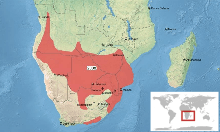Breviceps adspersus
| Common rain frog | |
|---|---|
| Conservation status | |
| Scientific classification | |
| Kingdom: | Animalia |
| Phylum: | Chordata |
| Class: | "Amphibia" (wide sense) |
| Order: | Anura |
| Family: | Brevicipitidae |
| Genus: | Breviceps |
| Species: | B. adspersus |
| Binomial name | |
| Breviceps adspersus Peters, 1882 | |
 | |
| Wikispecies has information related to: Breviceps adspersus |
The common rain frog or Bushveld rain frog (Breviceps adspersus) is a species of frog in the Brevicipitidae family.[2] It is found in Angola, Botswana, Mozambique, Namibia, South Africa, Swaziland, Zambia, and Zimbabwe. Its natural habitats are dry savanna, moist savanna, temperate shrubland, subtropical or tropical dry shrubland, subtropical or tropical moist shrubland, temperate grassland, subtropical or tropical dry lowland grassland, arable land, pastureland, plantations, and urban areas.[1]
Description
The common rain frog lives underground, only emerging to feed and mate after a rain, usually at nighttime. Its body is stout and globular, with a flattened face. The color of this species is either light or dark brown, with rows of lighter yellow orange patches, with darker borders. It also has the short, stout limbs typical of most burrowing frogs and toads. However, its back feet are like spades and are able to dig up to 20 inches below ground. If attacked, the frog inflates and lodges itself firmly inside of the burrow. The females are also much larger than males. Since the male cannot grip the female during mating because of the size difference, the female secretes a kind of glue from her back to keep the mating pair together. The stuck-together pair burrow backwards into the soil until they reach a moist spot. Once a suitable spot is reached, the female lays her eggs. The eggs hatch directly into froglets instead of tadpoles. They are one and a half to two and a fourth inches long (3 to 6 centimeters).[3][4]
The common rain frog inhabits temperate forests and open grasslands of southeast Africa. They are a terrestrial species. These frogs only breed in the rainy season. The population of this species is stable, and listed as "locally common".[3]
References
- ↑ 1.0 1.1 IUCN SSC Amphibian Specialist Group (2013). "Breviceps adspersus". IUCN Red List of Threatened Species. Version 2013.2. International Union for Conservation of Nature. Retrieved 30 November 2013.
- ↑ Frost, Darrel R. (2013). "Names described as 'Breviceps adspersus'". Amphibian Species of the World: an Online Reference. Version 5.6 (9 January 2013). Retrieved 30 November 2013.
- ↑ 3.0 3.1 "Amphibians". Animal: The Definitive Visual Guide to the World's Wildlife. Burnie, David and Wilson, Don E. (eds.). New York, New York: Dorling Kindersley, Smithsonian Institution. 2005-09-19. pp. p. 456. ISBN 0-7566-1634-4.
- ↑ Narrow-Mouthed Frogs: Microhylidae - Behavior And Reproduction
